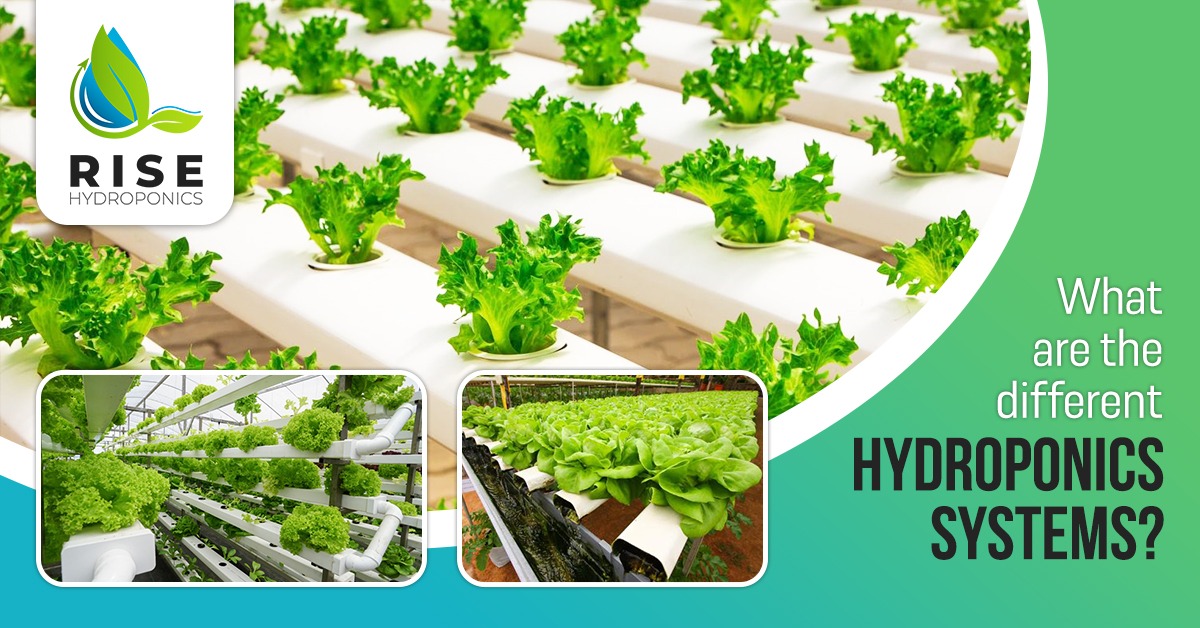Do you want your kitchen corner, the back garden, or the yard to be your veggie garden? Well, the increasingly popular method of hydroponic farming will help your dreams come true. Since soil is not used in the system, rockwool, perlite, clay pellets, or peat moss support the plant roots. You will be spoilt for choice because there are as many as seven. Some systems outdo the others, depending on the space you possess and the plants you are growing. Let us have a quick overview of the superb seven methods.
1. Aeroponics System
Have you ever witnessed vegetables grown out of thin air? The aeroponic system we are about to discuss is pretty much that. This system nourishes the plants with nutrient-laden mist and nothing else. The roots are held in a soilless medium of growth like coco coir. Nutrient-laden water has to be periodically pumped for plants to grow.
Yes, the method is quite futuristic and hi-tech, but it has been in function for quite some time now. A pipe system sends out a pressurized solution of nutrients to plants. Roots get the solution through the nozzles of the pipe in the form of droplets. This means that the roots will receive the nutrients and the moisture, besides being able to breathe freely.
INTERESTING FACT: With aeroponics, you have to irrigate for short times but quite frequently. A cycle’s frequency depends on the climate and crop type, besides the pressure you will use in the system.
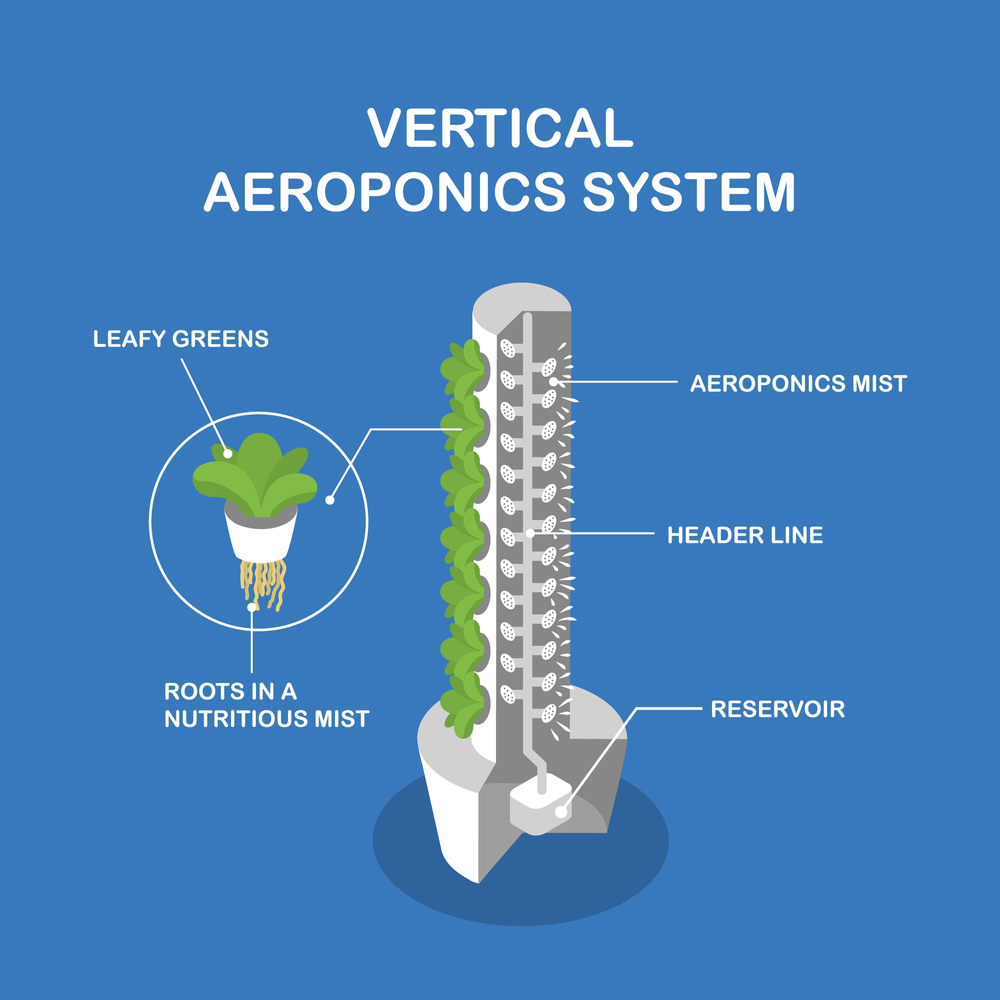
Things you need for Aeroponics
- A reservoir
- Hoses and pipes with sprayers and nozzles
- Time to set the irrigation cycles
- A durable aeroponics chamber
| PROS | CONS |
| Suitable aeration | Stabilizing the climatic conditions |
| Uses lesser nutrient solution | Not ideal for outdoor spaces |
| Drastically reduces the infection risks | Calls for higher costs for set up |
| Suitable for varied range of crops | Uses a lot of electricity |
| Produces higher yields significantly | Heavily depends on a well-working pump |
2. DRIP Hydroponic System
One of the most active hydroponic systems has to be the drip system. This one uses a pump for feeding the plants with water and nutrients regularly. You may have heard about it by the names micro-irrigation system or trickle system. This system makes use of tiny emitters to directly sprinkle the nutrient solution onto the plants. In fact it is a boon for the big problem of aeration as it provides constant watering and nutrition with the hoses, pipes, and growing media.
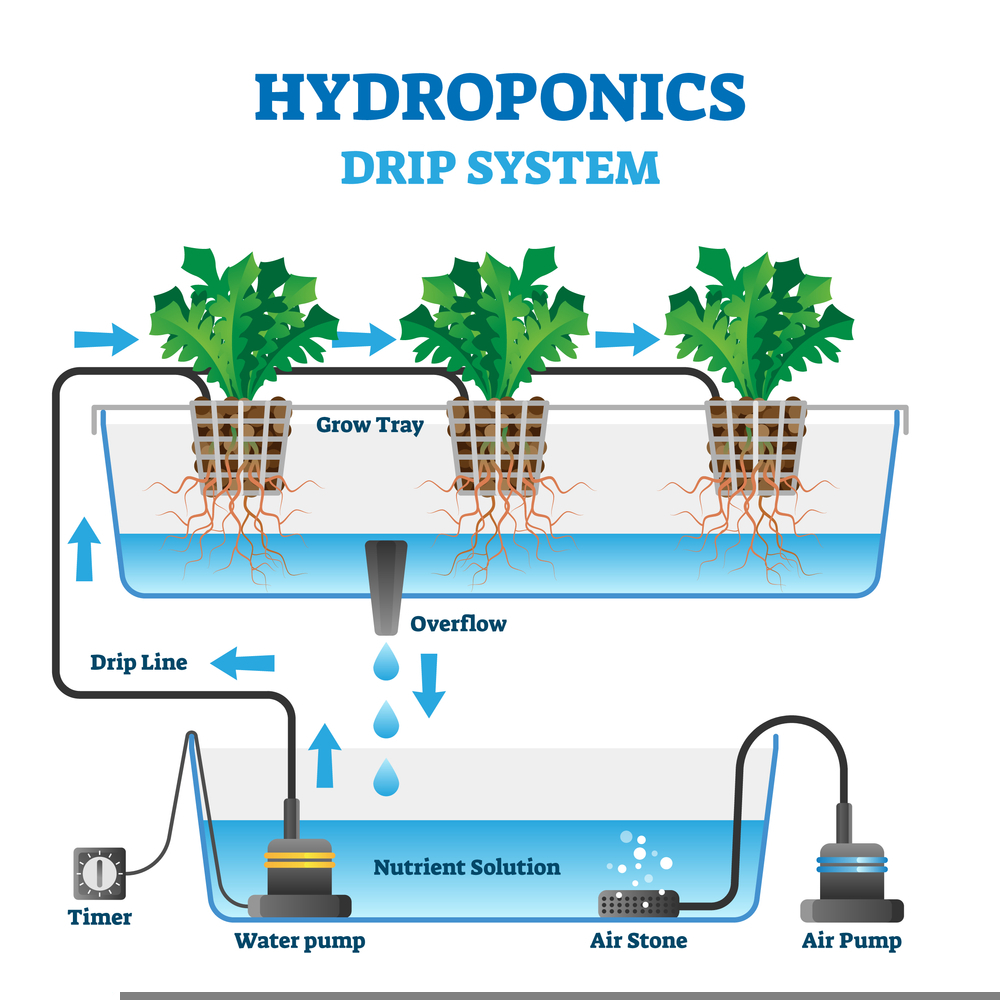
You can easily understand the system working. The method is all about 2 steps, one being fetching the nutrient solution by using hoses and pipes, from a reservoir. You can send the solution to individual plants. The second step involves sprinkling the solution on a growing medium that will further let out slowly.
Are you aware? Drip system was initially used for outdoor cultivation of plants in Israel to improve water efficiency. It was later adapted for hydroponics.
Things you need
- A reservoir for mixing the nutrient solution
- A water pump attached to the hose and pipe system to irrigate every plant
- Hoses and pipes
- Growing media
- An air pump for sure
- A timer, provided you want to irrigate in cycles
| PROS | CONS |
| perfect for all kinds of plants (fruit trees included) | Leakage is a common problem because the system uses too many hoses and pipes |
| Plants get perfect aeration | There are chances that your plants receive no nutrient for the longest time if the water pump stops working |
| Complete control over the amount of nutrient solution you want to give to individual plants | |
| Perfect for vertical towers and gardens | |
| Uses nutrient solution in low quantities |
3. Nutrient Film Technique
Did you face an aeration problem with any of the hydroponic systems you used? The nutrient film technique or NFT will solve that problem. With NFT, you will present a thin solution film at a tank’s fairly deep bottom. As a result, roots will receive water and nutrition while the upper part gets to breathe. If you see the roots mop-pressed, then do not fret because they are meant to look like that.

The most significant technical feature of this system is that the growing tank must not be perfectly horizontal. Make sure it has a slight angle. The slight tilt of the tank will not stagnate the roots with the solution, and neither will the solution flow away too fast.
NFT system dates back to the 60s. Infact it was pioneered by Allen Cooper at the Glasshouse Crops Research institute, England.
Things you need for set up
- A growing tank that needs to be slightly inclined
- A reservoir that will provide a nutrient solution for the garden
- An air pump or air stone to be placed within a reservoir
- Pipes for bringing the water to the growth tank and then back to the reservoir
- A water pump for bringing the nutrient solution to the growth tank
| PROS | CONS |
| It uses very little nutrient and water mixture | The system is not ideal for large plants |
| You can reduce the reservoir’s size | Roots may block the flow of nutrient solution |
| Root inspection is easier; all you have to do is take the plants | Not suitable for veggies like turnips or carrots because of tuberous roots |
| It uses very little nutrient and water mixture | The system is only ideal for leafy veggies |
| If the system breaks, then there will be no water or nutrition |
4. Ebb and Flow
If you are a home gardener, the ebb and flow system is for you. With this system type, you position the plants in a spacious growing bed. This bed is packed with a growing medium like perlite or rockwool. Once you have carefully planted the plants, you will flood the grow bed with nutrient solution. This system works on the principle of regularly irrigating the roots and for shorter periods.
In the name Ebb and Flow, Ebb indicates retreating water while flow indicates retreating water. Hence the nutrient flow like the tides in sea.
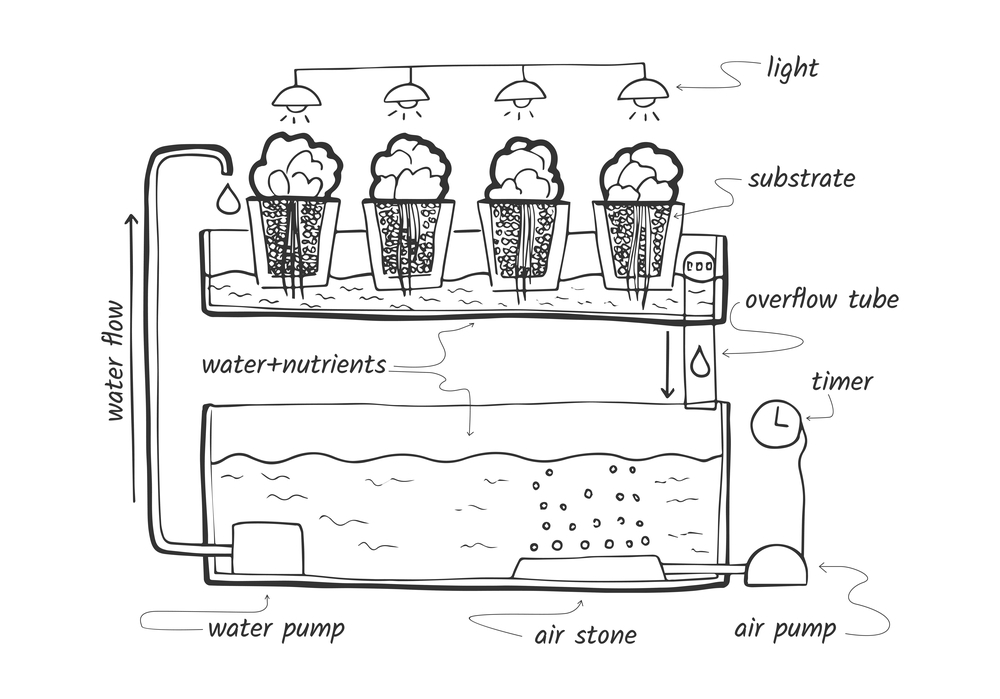
Things you need for set up
- A reservoir
- A growth tank
- Reversible water pump
- Air pump to aerate the reservoir’s solution
- Pipes for leading the nutrient solution from and to the tank
- A timer to switch the pump on and off
| PROS | CONS |
| Provides excellent aeration | Requires a complex set up |
| No stagnation of nutrient solution, thus a vast reduction in chances of pathogens, bacteria, or algae growth | Complex to run |
| You will control the watering and feeding of your plants | It is dependent on too many components |
| It is ideal for most kind of crops | Requires you to have sound knowledge regarding the humidity, watering, and nutritional needs of plants |
| It can be vertically developed Pump | clogging is common |
| Pipe breakage and clogging is also common |
5. Wick Hydroponic System
The most simplistic hydroponic system has to be the wick system. It requires no aerators, pumps, or electricity. Among the various kinds of hydroponic systems, this is the only passive system that can do without electricity.
Wick system gets its name as to how a candle wick draws wax or oil lamp draws fuels to light itself. In the same way, the wick system uses a capillary mechanism to feed nutrient solution to the roots.
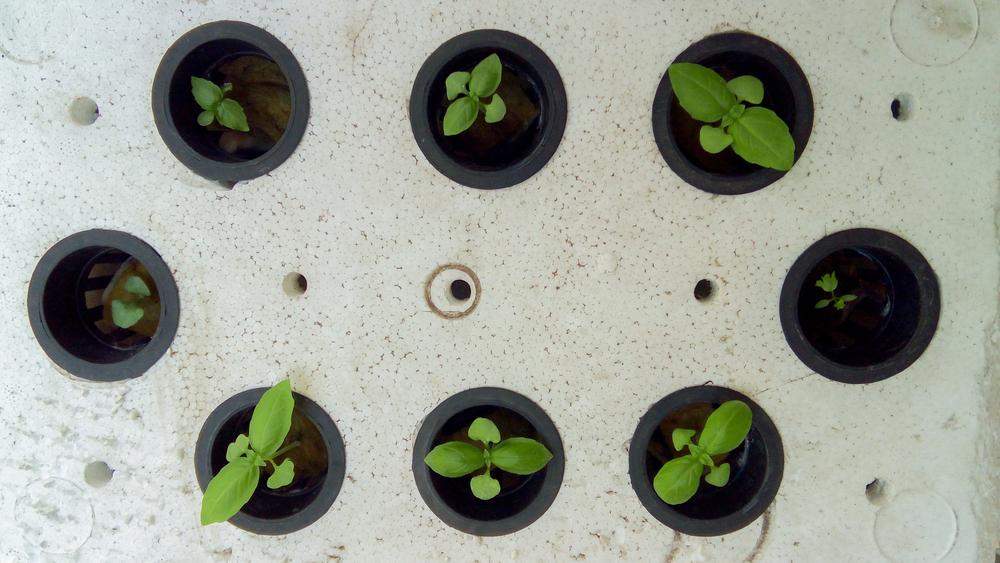
Things you need for set up
- A reservoir
- A grow tank
- More than one wick (ropes or spongy material)
- A medium for growth (coconut coir, any inter material, or expanded clay)
| PROS | CONS |
| The system is cheap and simple | Not suitable for towers or vertical gardens |
| It is not electricity or technology dependent | The system does face bacterial and algae problems |
| Recycles the solution of nutrients | It is unsuitable for larger plants or crops |
| It auto regulates the nutrient solution quantity as per the plant’s needs | |
| It provides great aeration | |
| It is a self-sufficient system that does not require pump operation |
6. Deep Water Culture
The DWC system works almost for all kinds of plants, but it is a blessing for large plants, especially those with big roots. In this system, the plant roots are suspended in a nutrient solution, and you directly provide the air with a diffuser or an air stone. You will have to place the plants in net pots with a medium for growth to secure them. When you make the plants sit in nutrients with unlimited oxygen being supplied, your plants attain crazy growth.
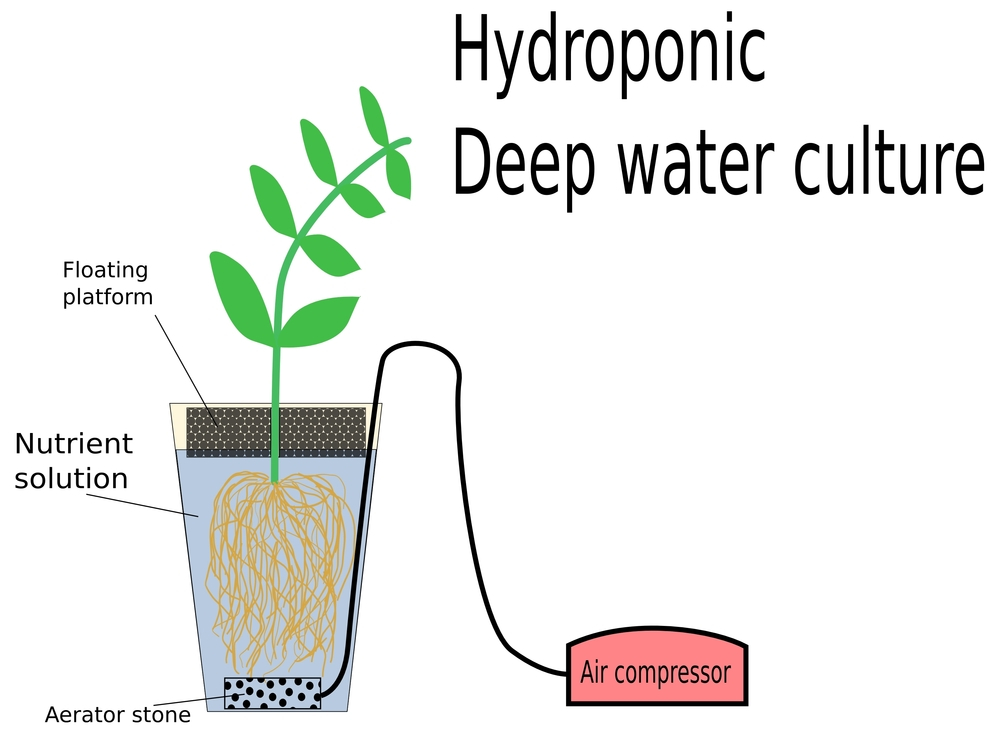
In Deep Water Culture, the roots are submerged in water 24/7.
Things you need for set up
- A grow tank
- Air pump
- Reservoir filled with nutrient solution
- A water pump
| PROS | CONS |
| Cheap and simple | Not suitable for plants like raspberries and pepper |
| Allows topping up the nutrient solution | It is not ideal for vertical gardens |
| Has an aeration form for the roots | A simple air pump provides great aeration |
| Still, water filled with nutrients does cause algae and bacterial growth | |
| Still, water filled with nutrients does cause algae and bacterial growth |
7. Kratky Method
The most rudimentary hydroponic system has to be the Kratky Method. It is quite an outdated method, and only amateurs use it. This method is a simple one that requires you to plant your plants with their aerial parts outside the solution.
Kratky method is best suitable for fast-growing plants like Lettuce, herbs and spinach. It is also suitable for tomatoes and pepper but you will need a larger container
Things you need
- Mesh pot
- A narrow-necked simple vase
- Grid
| PROS | CONS |
| Simple and cheap | The nutrient solution will run out after absorption in roots |
| Requires little to no maintenance | Suitable for small gardens and small plants |
| Very affordable | This system provides zero aeration to the roots |
| Requires few components |
What is the best method for you?
In order to find out which of these systems is best for you, know the features each one of them has. Identify your hydroponic needs and get going. Our carefully curated list of pros and cons will help you determine your ideal method.

